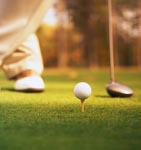Secrets behind the perfect golf swing revealed
 London, November 5: English researchers have found that the wrists do not play a critical role in the perfect, long-distance golf swings.
London, November 5: English researchers have found that the wrists do not play a critical role in the perfect, long-distance golf swings.
Robin Sharp, an engineer at the University of Surrey, says that how and when the power develops is the key to distance.
His analysis is based on a computer model in which a golfer uses three points of rotation: the shoulders relative to the spine, the arms relative to the shoulders and the wrists relative to the arms.
While it has long been believed that the timing of these rotations relative to one another is the key to a long drive, Sharp’s study is the first to optimise such timings and how the power of a swing is developed as a golfer plays out.
Previous studies assumed that either the torque (power in rotation) was applied at its maximum from the backswing or it ramped up throughout the swing to reach its maximum at the point of impact.
Sharp used his computer model to fit to the swing styles of Bernard Hunt, Geoffrey Hunt, and Guy Wolstenholme, whose swings were measured with high-speed photography in 1968.
The model showed that the three professionals could have improved their drive distance by increasing the torque (power in rotation) quickly to the maximum value, and maintaining it throughout the rest of the swing.
However, he admits that it is a delicate balance, and that people may find it hard to implement this prescription.
"Generating too much arm speed too soon causes an early release, with the club-head reaching its maximum speed before it arrives at the ball," the BBC quoted him as saying.
Based on his observations, Sharp suggested that the perfection of a swing depends upon the application of torques in accordance with the need, and that contrary to the old saying, it is not all in the wrists.
"In the expert swings studied, control of the arms and not the wrists appears to be the priority. The optimal strategy consists of hitting first with the shoulders while holding back with arms and wrists and, after some delay, hitting through with the arms. At release, the wrists should hit through," he said.
The study also suggested that height was not much of an advantage in a long-distance swing.
"A 21 per cent bigger player can be expected to have just a 10 per cent advantage in club-head speed," Sharp said, which he said accounted for the fact that "good little ones are often not so far behind good big ones."
A report describing Sharp’s study has been published in the journal Proceedings of the Royal Society. (ANI)